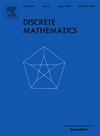Tyshkevich's graph decomposition and the distinguishing numbers of unigraphs
IF 0.7
3区 数学
Q2 MATHEMATICS
引用次数: 0
Abstract
A c-labeling of graph G is distinguishing if, for every non-trivial automorphism π of G, there is some vertex v so that . The distinguishing number of G, , is the smallest c such that G has a distinguishing c-labeling.
We consider a compact version of Tyshkevich's graph decomposition theorem where trivial components are maximally combined to form a complete graph or a graph of isolated vertices. Suppose the compact canonical decomposition of G is . We prove that ϕ is a distinguishing labeling of G if and only if ϕ is a distinguishing labeling of when restricted to for . Thus, . We then present an algorithm that computes the distinguishing number of a unigraph in linear time.
Tyshkevich的图分解和单图的区分数
图G的一个c标记φ:V(G)→{1,2,…,c}是为了区分对于G的每一个非平凡自同构π,是否存在某个顶点V使得φ (V)≠φ (π(V))。G的区分数D(G)是最小的c,使得G有一个区分的c标记。我们考虑了一个紧凑版的Tyshkevich图分解定理,其中平凡分量被极大地组合以形成完全图或孤立顶点图。假设G的紧形正则分解是Gk°Gk−1°⋯G1°G0。我们证明了当且仅当当i=0,…,k时,当φ被限制为V(Gi)时,φ是Gi的一个可分辨标记。因此,D (G) = max{D (Gi), i = 0,…,k}。然后,我们提出了一种在线性时间内计算单图的区分数的算法。
本文章由计算机程序翻译,如有差异,请以英文原文为准。
求助全文
约1分钟内获得全文
求助全文
来源期刊

Discrete Mathematics
数学-数学
CiteScore
1.50
自引率
12.50%
发文量
424
审稿时长
6 months
期刊介绍:
Discrete Mathematics provides a common forum for significant research in many areas of discrete mathematics and combinatorics. Among the fields covered by Discrete Mathematics are graph and hypergraph theory, enumeration, coding theory, block designs, the combinatorics of partially ordered sets, extremal set theory, matroid theory, algebraic combinatorics, discrete geometry, matrices, and discrete probability theory.
Items in the journal include research articles (Contributions or Notes, depending on length) and survey/expository articles (Perspectives). Efforts are made to process the submission of Notes (short articles) quickly. The Perspectives section features expository articles accessible to a broad audience that cast new light or present unifying points of view on well-known or insufficiently-known topics.
 求助内容:
求助内容: 应助结果提醒方式:
应助结果提醒方式:


